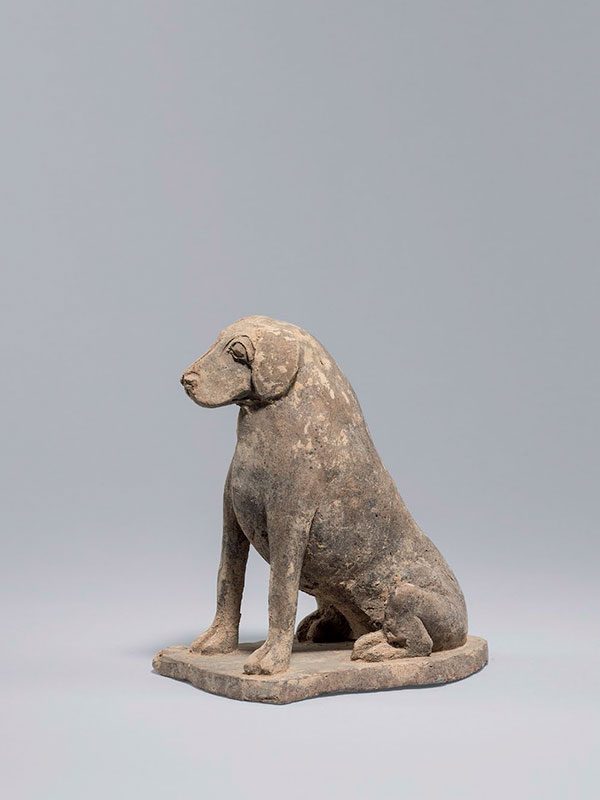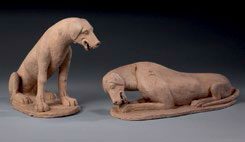Pottery hound Northern Wei dynasty
A pottery hound with naturalistically modelled features, depicted seated on an irregularly shaped flat base. The dog looks straight ahead, with his front legs placed sturdily on the base. It has finely defined, somewhat doleful facial features, pendant ears, wide open eyes and a mouth drawn into a reserved expression. The dog is solidly potted and covered in an ochre pigment.
A dog (gou) is among the twelve signs of the Chinese zodiac and is one of the oldest domesticated animals in the Chinese world. According to Chinese mythology, after the first ‘Mother’ and ‘Father’ (Nuwa and Fuxi) created mankind, they created the dog before all other animals – which is said to be the reason why the radical form of ‘dog (quan)’ is so common in written Chinese characters.[1] Domestic dogs in China are descended from five ancient types: the spitz, sheepdog, greyhound, pariah, and mastiff.[2] The greyhound, which is probably the type of dog represented here, is shown in stone reliefs of the Han dynasty (206 BC – 220 AD). Elegant hounds have long been associated with high rank and status.[3] Two comparable pottery dogs, one in a similar seated position and the other reclining and licking its front paws, were excavated from a Northern Wei dynasty tomb in Datong county, Shanxi province, and are now in the collection of the Datong Museum (fig. 1).[4] Two Northern Wei painted pottery dogs, each reclining on a flat base with paws crossed and tails curled to one side, are in the Meiyintang collection.[5] A comparable model of a recumbent dog with a puppy is in the collection of Anthony M. Solomon.[6] Two dogs in crouching position are respectively in the Museum of Far Eastern Antiquities, Stockholm[7] and in the collection of Sir Alan and Lady Barlow.[8]
- Welch, P. B. Chinese Art- A Guide to Motifs and Visual Imagery, Tuttle Publishing, Singapore, 2012, p. 118
- Schafer, E. H. The Golden Peaches of Samarkand, University of California Press, London, 1963, p. 76; cited from Keller, O. Die Antike Tierwelt, vol. I, Leipzig, 1909, p. 91
- Welch, P. B. op. cit. p. 119
- The Datong Museum online collection archive, webpage: http://www.datongmuseum.com/ product.php?id=264
- Krahl, R. Chinese Ceramics from the Meiyintang Collection, vol. Three (I), Paradou Writing, London, 2006, no. 1166, p. 160
- Bower, V. L. From Court to Caravan – Chinese Tomb Sculpture from the Collection of Anthony M. Solomon, Harvard University Art Museums, Cambridge, 2002, no. 17, p. 89
- Watson, W. Pre-Tang Ceramics of China- Chinese Pottery from 4000 BC to 600 AD, Faber & Faber, London, 1991, p. 218, no. 130
- Sullivan, M. Chinese Ceramics, Bronzes and Jades in the Collection of Sir Alan and Lady Barlow, Faber & Faber, London, 1963, p. 20, pl. 4b
灰陶狗
北魏 五 – 六 世紀
高:12.5 公分 長:12 公分
泥質灰陶狗,素胎無釉,坐於平板上,前肢踞地撐起雄壯上身,後肢彎曲踞地,面部刻畫精細,昂首
垂耳,圓睜雙目凝視前方,神態平和。狗位列中國十二生肖,也是中國社會中最古老的馴養動物之
一。相傳上古女媧與伏羲摶土造人,在造其他萬物之前先造出狗,是以狗的象形字「犬」是從「人」
字衍生而來。本品依據造型研判,應為「中國細犬」(外貌與西方「靈緹」或「格力犬」相似),為
中國古老犬種之一,據考察最早在西漢時經絲綢之路由阿拉伯國家傳到中國,曾出現於西漢畫像磚
中,經多年演化後,細犬分成河北、山東、陝西三的不同品種。中國細犬為古代貴族身份地位表徵,
常與蒼鷹結合成為貴族狩獵的慣用組合。山西大同縣蔡庄村北魏墓出土兩件北魏陶狗,一臥一坐,神
態與本品相似。玫茵堂、瑞典斯德哥爾摩遠東博物館及艾倫爵士和巴洛夫人之私人收藏中,均有北魏
陶狗收藏。


